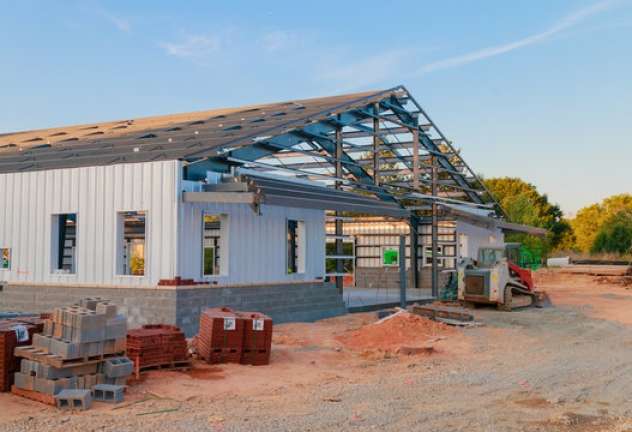A container home, as the name implies, is a house constructed from shipping containers. Many shipping containers are made of steel which underscores their hardness and toughness. Containers transport commodities on ships, trucks, and trains across the world. But today, people create houses of various forms and dimensions out of these massive blocks.
A shipping container can be manufactured in any shape or dimension; the most common sizes are 10ft, 20ft, and 40ft. A tiny cargo container can provide free or available square footage of around 100 square feet.
Furthermore, eight big containers combined can create a floor space of around 1400 square feet. This is almost a two-story home. What if you put a bunch of container micro-apartments next to each other? You’ll have a massive residential structure.
So, what’s the beauty of constructing a house, a studio, a cabin, or an office out of a shipping container? We can assume that thousands and millions of shipping containers are manufactured every year. You can imagine that many containers are left unused and abandoned. For sure, these containers are readily available for residential and commercial use.
Aside from being stylish, the joy of building container homes is part of a larger goal in cutting costs with ready-made and customized residences. Most prospective owners are seeking inexpensive maintenance and construction costs.
On the good side, it is understood that container houses contribute to recycling programs. Do you feel a container house is the best option for you? Here are some pros and cons about shipping containers being turned into lovely homes:
Pros of Shipping Container Homes
- Eco-Friendly Building
Building a shipping container home has a beneficial environmental impact compared to traditional house construction. It should be noted that a shipping container home is constructed using ‘out-of-service’ shipping containers. This means fewer large pieces of metal end up in junkyards.
On the other hand, a normal home is made using wood beam framing. The environmental effect of cutting trees, making wood beams, and transporting tools to your construction locations is greater.
- Fast Construction
Container manufacturing is substantially quicker than standard methods of construction. A tiny house, for example, may be constructed or fabricated in three weeks using off-site manufacturing. This implies that larger homes may be completed in a few months.
Before a container arrives at its final destination, several minor details and upgrades must be accomplished. Furthermore, shipping containers are ideal for those people enjoying DIY (do-it-yourself) projects. However, consulting with a competent production company or an expert is a good idea before embarking on a project like producing insulated shipping containers.
- Inventive Freedom
A shipping container may be modified in various sizes, giving you a choice to build a house, whether big or small. The benefit of a shipping container is that it can be joined together to make extra room.
If you like to feel the early sun in your house, you can create wide windowpanes to brighten up the room and allow plenty of sunlight from the sun. Alternatively, you may fix one or two glass doors to liven up the room in your container house.
Choosing a shipping container allows you to express your originality. The standards and conventions of normal architectural and structural design are overlooked when it comes to shipping containers, allowing you to be inventive.
Choose high or tall containers for greater flexibility. Even if you add something like an insulation system, you’ll still have extra room for adding devices like fans. A normal height container will suffice if you don’t need a high cube container. All of these will allow your artistic side to shine.
Cons of Shipping Container Homes
- Challenges With Building Licenses And Codes
Building houses out of shipping containers is a relatively recent development in some areas and countries. As a result, no officially acknowledged or controlled certifications and building rules for guidance exist. While some nations have standards for building shipping container homes, potential buyers are frequently met with red tape.
So, before you start building a shipping container house, check with your local municipal planning officials about laws, zone requirements, and license regulations for container homes.
- Shipping Container Homes Can Have Architectural Problems
Shipping containers are mainly steel, which means they’re incredibly sturdy, especially at the corners. However, the top isn’t designed to endure force, pressure, or wear, so you may need to build another top over it, especially if the weather changes.
As a result, your container home might need to be insulated to be habitable. For example, the interior can get quite hot during the summer and become extremely chilly during the winter. Heat travels easily through steel structures.
As a consequence, insulation aids in maintaining inside temperatures while mitigating the effects of weather. Depending on the weather in your area, you might need to insulate and weatherproof your surroundings to maintain constant internal temperatures for maximum comfort.
A shipping container is formed into parallel ridges and grooves for extra stiffness and strength. As a result, if you cut a large window or construct an opening for a door, you’ll need additional or extra reinforcement.
Furthermore, when numerous containers are piled together to build a larger residence, a substantial amount of welding reinforcement is required, which may be quite expensive. As with any construction, you’ll need to undertake some restorations or upkeep from time to time, including extensive engineering and soldering.
- Risk Of Some Health Hazards
Please keep in mind that shipping containers aren’t meant for human occupancy because they’re made with manufacturing paints and acetones. They might be harmful to your health if you remove them without the proper safety gear.
Some containers may carry poisonous substances, and remnants of these substances are occasionally left in the container. As a result, before acquiring a container, you must determine the items placed or stored in it.
Final Thoughts
Because it is eco-friendly, shipping container homes are gradually becoming the best housing alternative. A shipping container home is also less expensive than a traditional home. They’re a fraction of the expense of constructing a normal home, and you’ll need fewer resources.
However, there are advantages and disadvantages of shipping container houses. Take some time to analyze the benefits and drawbacks of having a shipping container as your home.















